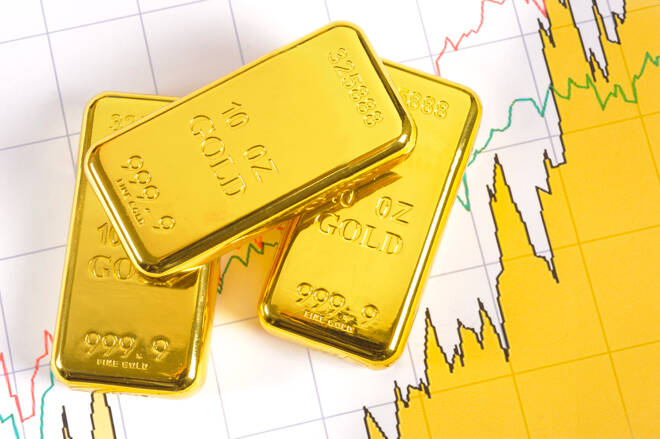Advertisement
Advertisement
Gold Price Prediction for 2022
By:
Gold could remain soft in the first quarter but starting in Q2, we see the potential for a strong breakout advance.
- After performing poorly in 2021, gold prices are historically undervalued and should do much better in 2022.
- Gold could remain soft in the first quarter but starting in Q2, we see the potential for a strong breakout advance.
- If gold adheres to our technical outlook, we think prices could reach $3000 by the end of next year.
Negative Real Rates
The post-pandemic price action in gold has been surprising. Historically, gold thrives during periods of high inflation and negative real interest rates. In the chart below, you’ll see that 5-year Treasuries have yielded -1.5% for much of 2021. With real yields profoundly negative, shouldn’t gold be soaring?
What Caused Gold’s Underperformance?
I see two distinct factors contributing to gold’s underperformance over the last 12 to 16-months:
- From August 2018 to August 2020, gold rallied from a low of $1167 to a high of $2089. After a sharp 80% rise, an extended consolidation was expected. We saw something similar following gold’s breakout in 2004.
- A record number of government stimulus payments (stimmies) went out to unemployed Americans. While some of that money went to essentials, much of the excess was gambled on meme stocks and altcoins as out-of-work Millennials tried to get rich day trading. That kept gold out of favor.
Gold’s Technical Setup
As a technician, I’m always looking for historical price patterns to help forecast future moves. In gold, I see overwhelming similarities between now and the 18-month consolidation between 2004 and 2005. This pattern, if it holds, supports a convincing breakout in 2022 and a rally towards $3000 by year-end.
GOLD WEEKLY CHART
Gold is in a similar setup to 2005. The post-breakout consolidation that started in August 2020 is almost over. Expect renewed bullishness beginning in Q2 2022 that should last into year-end. Our most bullish case suggests gold could challenge the $3000 level.
Focus on the similarities between the 2020/2021 consolidation and the post-breakout consolidation of 2004/2005. I believe we are finalizing the ending triangle consolidation now, and a decisive breakout should follow in the second quarter of 2022, possibly as soon as February or March.
In summary, we expect much better performance from gold in 2022, with the potential for a 60% advance from current levels. Gold miners could outperform to the upside and may double from current levels. Our Basic Metals Portfolio is overweight and will continue to add high-quality assets in 2022.
After rising to $3000 in 2022, we expect another consolidation, followed by new highs in 2023 and then a more profound decline in 2024.
AG Thorson is a registered CMT and expert in technical analysis. He believes we are in the final stages of a global debt super-cycle. For regular updates, please visit here.
About the Author
AG Thorsoncontributor
AG Thorson is a registered CMT and expert in technical analysis. He believes we are in the final stages of a global debt super-cycle that will begin to unravel in 2020.
Did you find this article useful?
Latest news and analysis
Advertisement
